The Collage is Queer: Three Artists, Three Approaches
Author
Joshua Muyiwa
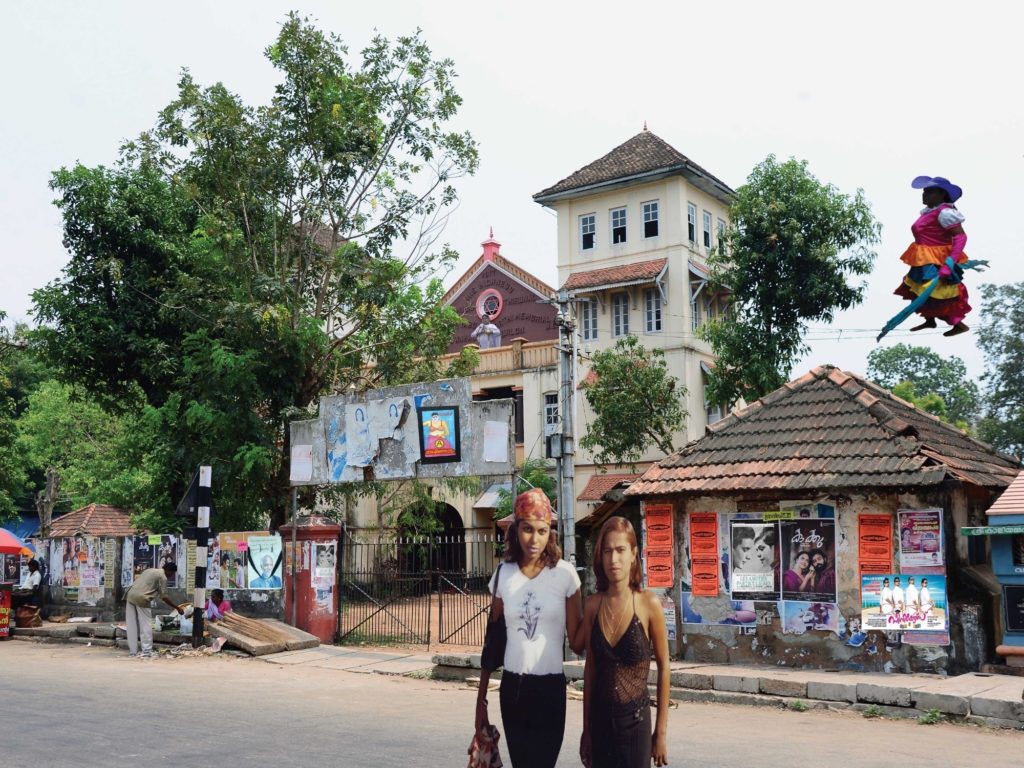
The Birth of the Collage
It wasn’t until the early twentieth century, when Georges Braque or Pablo Picasso started gluing paper onto the canvases of their geometrical paintings, to fight the ‘flatness [that] had not only invaded but was threatening to swamp the Cubist picture,’ as explained by the American art critic Clement Greenberg1. In doing so, they stumbled onto the new modernist art form of the collage. This technique comes from the French word, coller, to glue.
Hannah Höch, a German Dadaist, ran with this form. Her photomontages were a means to access the subconscious, political and absurd. She was hell-bent on dismantling the myth of the ‘new woman’ which was a term used to describe the newly-emerging feminist – educated and independent women of the mid-twentieth century. Through works like Das Schone Madchen/The Beautiful Girl (1919-1920), Hannah reconfigured and reframed photos from women’s magazines to question this new notion of the modern woman.
The collage allowed for the pushing together of fragmentary materials from different spatiotemporal situations to reveal something else. The collage, much like the daily central practice of the queer subject, is tasked with constructing new worlds and identities from the same materials as everybody else. The act of collaging resonates with the queer subject’s ability to recast violence, to rearrange the aggressive and to reflect the substance in style.
It is this possibility of something else to emerge that caught the magpie eyes of queer artists like David Wojnarowicz, who expanded, extended and exploited this space to tell different stories using the mainstream images that were utilised to critique the AIDS crisis of the 80s. In seeking to figure out this relationship between queerness and collage, this essay will speak of three queer Indian artists to understand their impetus and interest with making such works.
Manipulating Media And Memories
Aryakrishnan R, a Kerala-based artist-curator has always cut clippings from the newspapers and magazines in a bid to identify with something. He collected and collated everything from write-ups about Oscar Wilde to the Sydney Mardi Gras. Though, he has found himself with mostly crime stories and oddities like ‘a hen becoming a rooster’ but all of these things were the bits and bobs to make up his own history in the pre-Internet era.
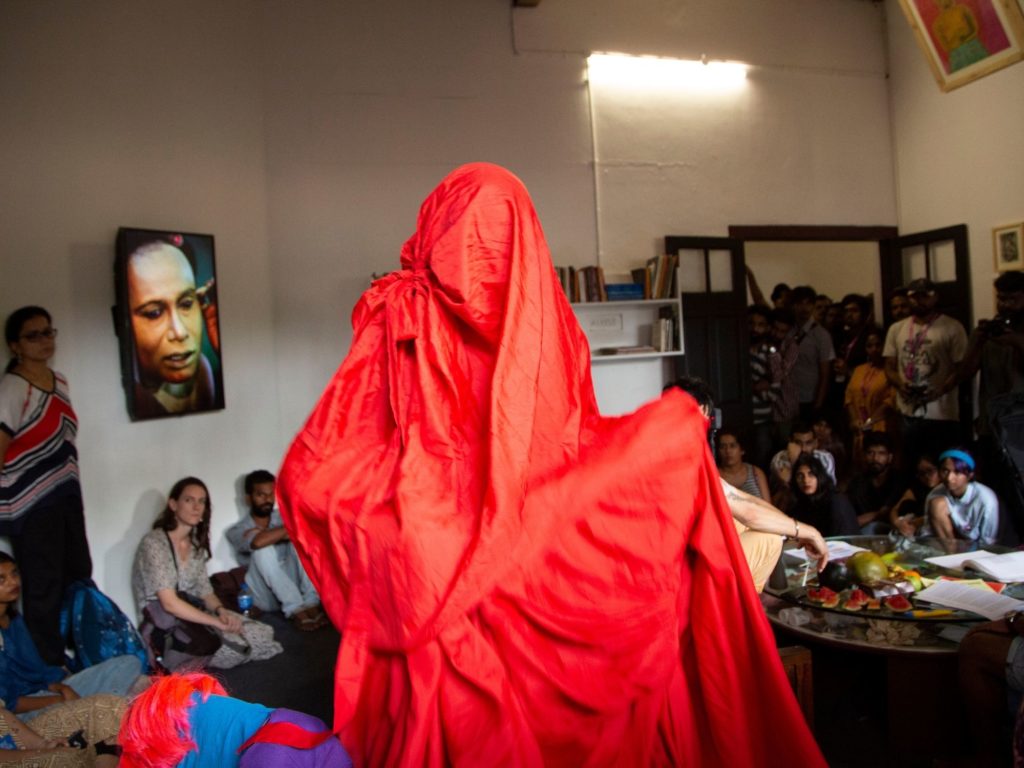
One of his first impulses towards the technique of collage was the want to ‘do things with the headlines’ but without necessarily writing anything. He started purely by accident; shuffling the material, cutting up the headlines and wondering ‘if cutting up the text’ rendered them as images ‘and therefore allowed for another kind of reading’. He followed his gut feeling and even though he started off with nothing, cutting up and gluing them as materials onto a surface ‘revealed a new beauty’ towards the end for Aryakrishnan. He found that the resulting work had undone, unlocked and uncovered ‘a different potential’ that wasn’t simply illustrative. ‘We weren’t given things to identify with,’ says Aryakrishnan of his years growing up in the 80s, ‘so I was actually taking things not meant for me and making it fit as something else for me, this [collage] seemed an extension of that endeavour.’
For Aryakrishnan, the process of putting together a collage helped him create new meanings from stacks of ‘broken images’ squirrelled away from a brief moment in a film, a throwaway line in a song or even a headline about a violent crime in the newspaper. Over the years, he has been able to coax out a vocabulary that has emerged from ‘painstakingly doing the work of parsing new meaning’ guided by his practice of using materials already in the world.
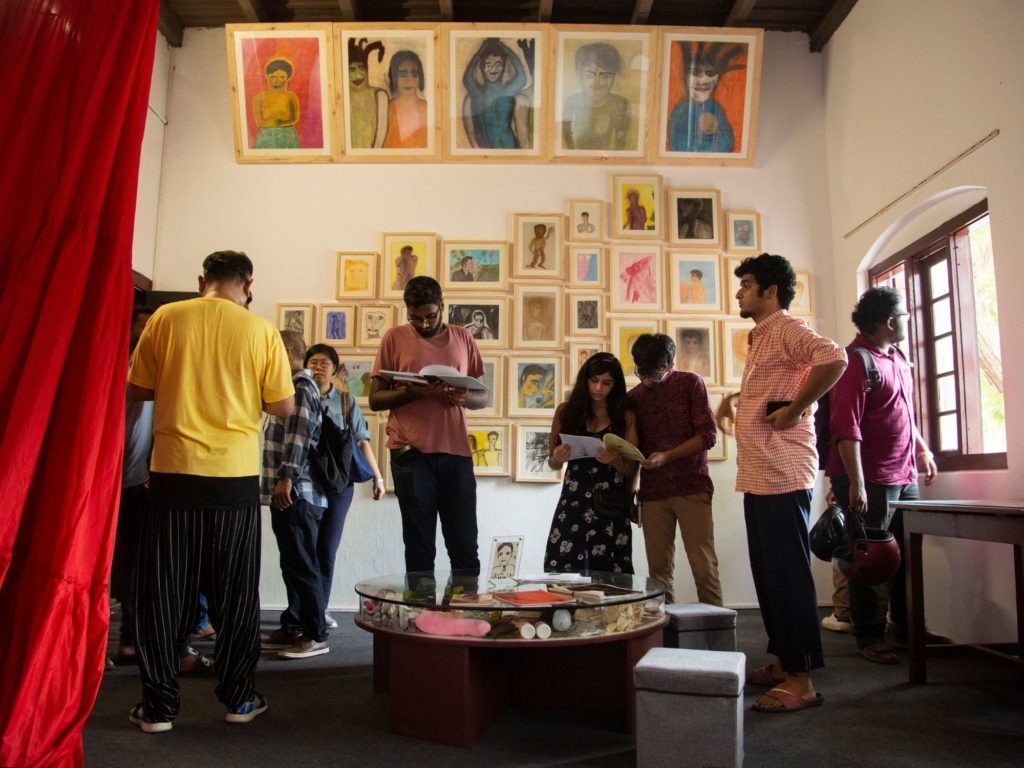
In 2018, as part of the Kochi-Muziris Biennale, Aryakrishnan presented Sweet Maria Monument, which was a physical collage of prints, performance and paraphernalia that marked the life and death of Maria, a transgender activist, who was brutally murdered on 10 May at her home in Kollam, Kerala. Through this work, much like his collages, he manages to manipulate not only media but also memories to leave the audiences with something new, something else. We’re left with a different take on the world, and a layered look at the life of a trans person.
Play, Postcards and the Physical World
This must-have skill of the queer subject to ‘restructure’ the world around them in order to find a footing aligns with the process of the collage for each of these artists. Approaching and analysing this task of remaking differs among them. For the artist Sandip Kuriakose, his early work was interested in using borrowed images from pop culture ‘that had some kind of history’. Similar to Aryakrishnan, he understood that these images came with their own framing and the ‘value to reframing it’. While Aryakrishnan’s work has opened up to gluing together drawings, drama and design to fill up an entire room – allowing for an immersive experiencing of the something else; Sandip’s work, tries to ‘understand spaces’ to provide us with a ‘printed postcard’ made up of the snatches of colours, contours and the covertness of cruising spaces2.
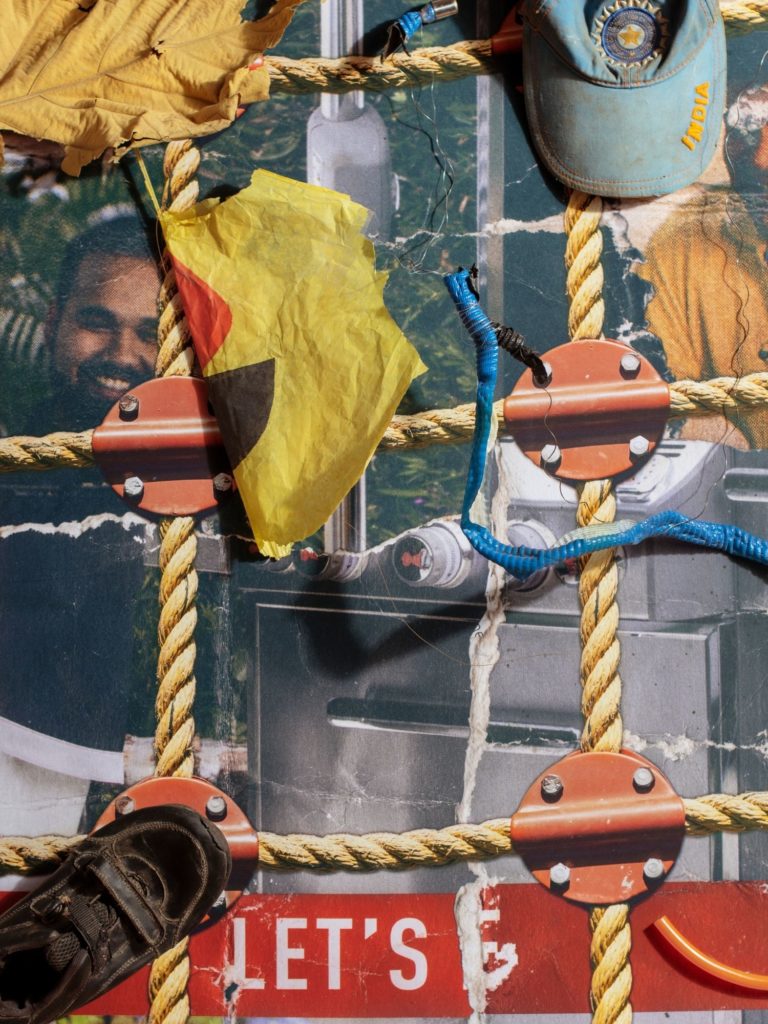
In a way, Sandip has arrived at giving his work with collage a different effect while still using the basic techniques of the form. He isn’t limited by the borders of the four corners of a canvas, or of a room, but rather likes things ‘to push out, to have some kind of spillage’ and challenge the ‘restriction of the frame’. This move in his practice is from observing the ways that cruising spaces are ‘a restructuring of space, not just ideological, in the sense that these public spaces aren’t meant for that, yet there are queer men who seamlessly see it for its sexual possibilities and potency’.
In his on-going series, Woh bhi line ka tha3, Sandip uses collage as a starting point for ‘its ability to put things from different sources together to create a new image’ and also as an aesthetic choice seen in ‘the jarring disjuncture between Image 1 and Image 2’. He points out these markers in his present works when he points out these disjunctures between flat background and object, between colours and textures, between Thing 1 and Thing 2.
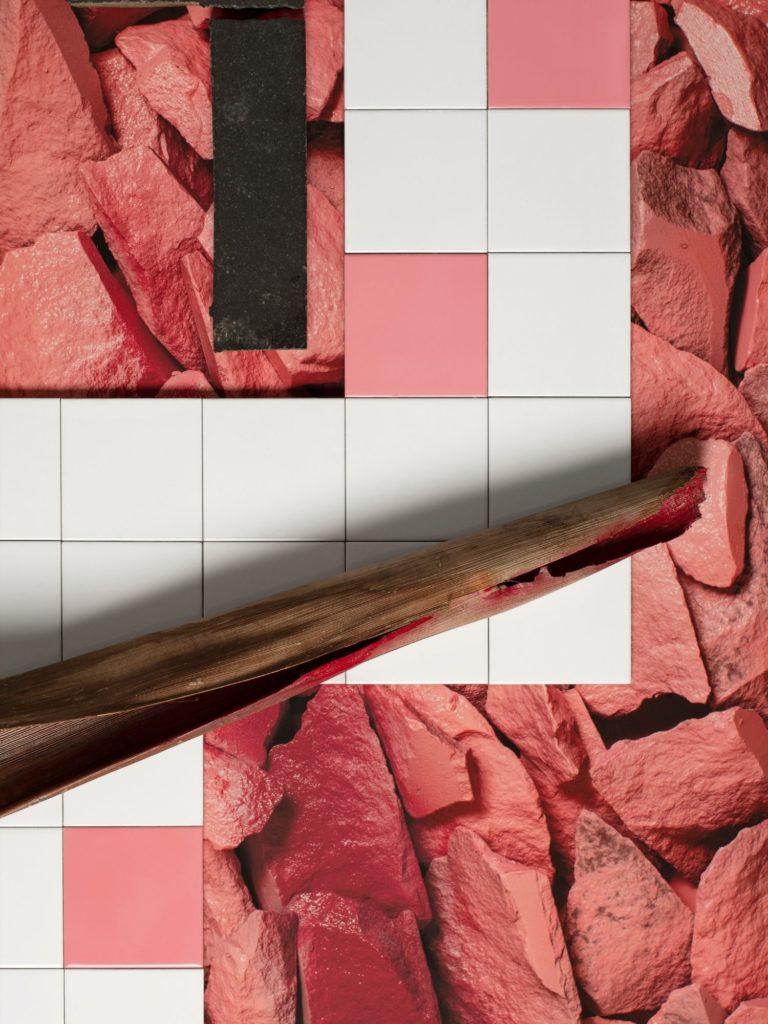
Presently, Sandip continues to play with the elements of the collage process. It plays with his audience too – inviting those who might not know, to be drawn by the work and the thought gone into creating his pretty, precise and potent images. But for those in the know, it works as postcards from a queer utopia – where even a little corner of a park, dumped with garbage, has the potential to be seen as a secret, somewhere else.
Figuring Out Fantasy
This nose for beauty, an eye for fantasy and the handy ability to edit together text and image to present an interesting story are the gifts of being queer; of being unconsidered by the mainstream. And collage, as a medium and a process, has engendered queer artists to share their thoughts, topography and textures of our shared world. Bangalore-based artist Renuka Rajiv’s works embody these gifts in the way that her canvases – both small and large – have this pull of portals. On diving in, it is populated with figures that aren’t defined by their genitals lounging in multicoloured fantastical spaces where shapes are sexy, and everything is in excess. In Renuka’s work, there is a full use of the freedom and flexibility of collage with ‘which a former whole can be made into fragments, likely combined with parts of other former wholes now made into fragments can be assembled together till they feel right’.
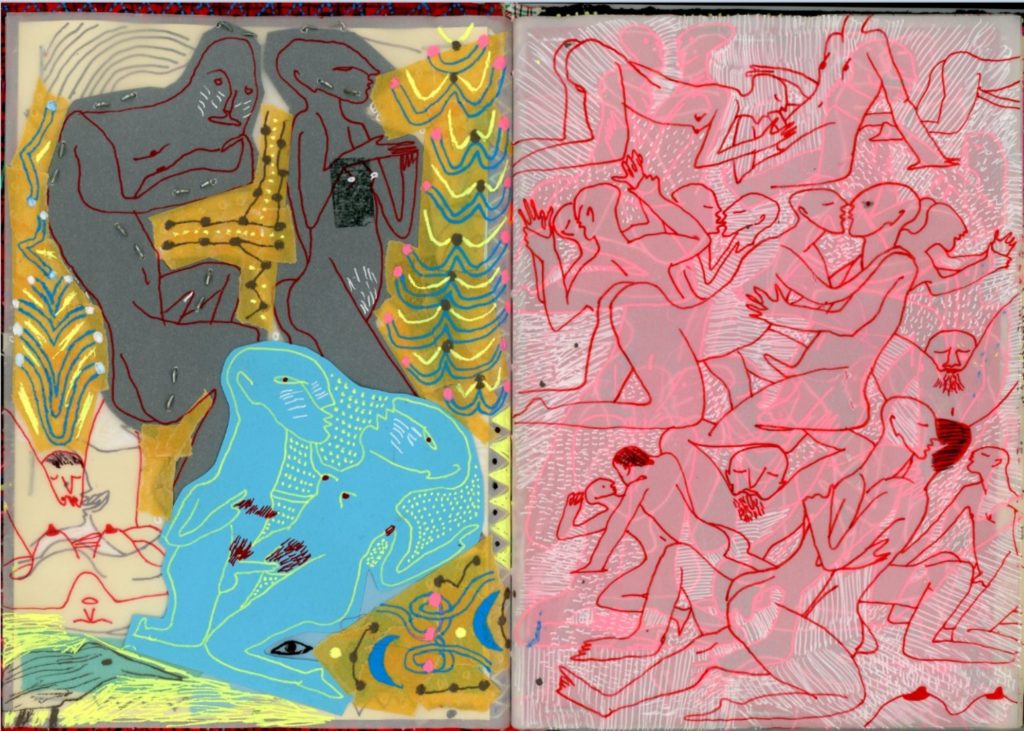
Through Renuka’s works, there is an ability to see the many tracks taken to arrive at this ‘feel right’ that Aryakrishnan and Sandip use as a compass too. One notices it in the changing colour of the thread in a line of stitching, the shift in the ink or even the changing precision of the cuts. Looking at the work, the labour of collage is evident; we see the pluck of starting off, the pace of keeping it going and the peacefulness, as well as the occasional panic of arriving at the end. In Renuka’s collages, ‘sometimes it’s a light and quick set of gestures’ that lead to the something else which can be left as is but this isn’t always the case. In their work, it might end up as a process of incessant layering, ‘less clear, less satisfactory but that needs to be left to whatever it is’ at some point, which clues us into the time it takes.
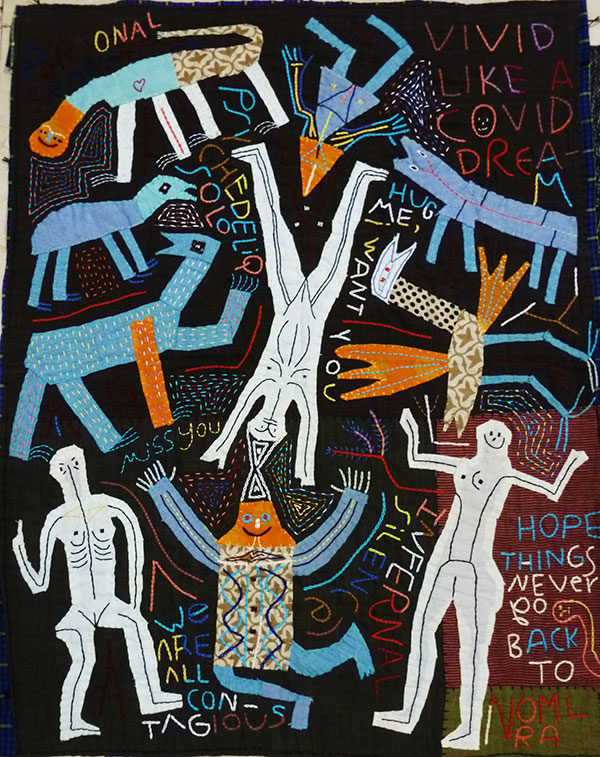
‘Each collaged entity shares a presence outside of recognisable meaning’ for Renuka and searching for it is the rigorous undertaking of collage. Over the past year or so, locked up at home like everyone else, they have continued to persist at this task. Continuing their work which started out as collaging bits from different books physically onto paper ‘and seeing how sentences could be formed and made to veer and waver’ has presently extended to taking notes made from discussions from online theory reading groups to create ‘live text collages’. Besides a way of keeping their hands busy while listening to these sessions, it has become a way to ‘access content as well as scramble it’.
Mix and Match
In the ways that each of these practitioners approach the collage, it becomes a medium to distill, disrupt and direct our attention. We’re taught to re-look at the media around us; invited to puzzle, play and push these images bombarded at us and locate ourselves. We’re asked to imagine that something else is possible with these pictures.
Aryakrishnan takes headlines, crime stories and the archive of queer bodies and turns them into immersive mausoleums; Sandip restructures memories of physical spaces to make postcards from a world not quite there; and Renuka collages together materials, moods, and a multitude of techniques to reveal the fantastical and the whimsical. Each of these artists through their practices with collage offer up new futures, or point to the present having the potential for mixing and matching till something else appears – and that’s certainly queer.
Notes
1 Clement Greenberg’s essay Collage, which appeared in the 1958 issue of Art and Culture.
2 Cruising is seeking out of sexual encounters between queer men in public spaces. This sexual practice generally occurs in public places like parks, toilets and parking lots
3 Translated from Hindi, it means “he was one of us”, a commonly used term in cruising spaces.
All quotes within the sections belong to the artists interviewed unless specifically mentioned otherwise.
About the Author
Joshua Muyiwa is a Bangalore-based poet, columnist and writer.

